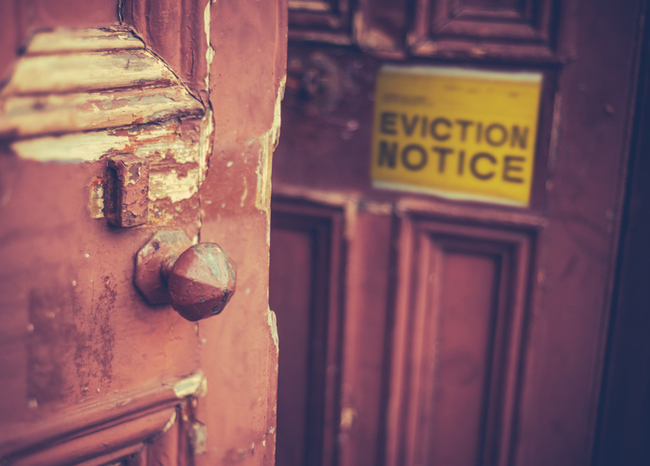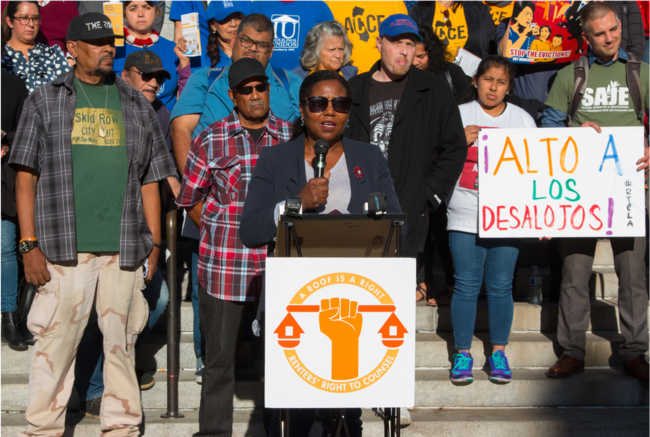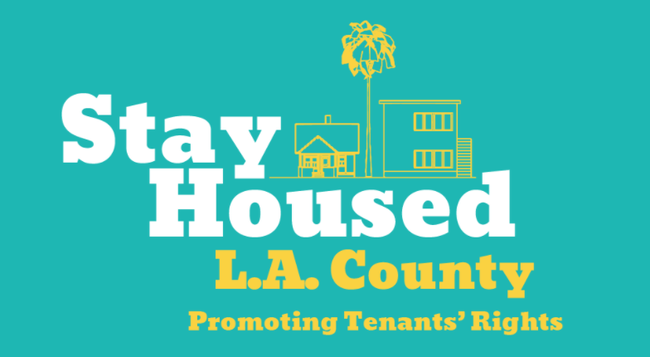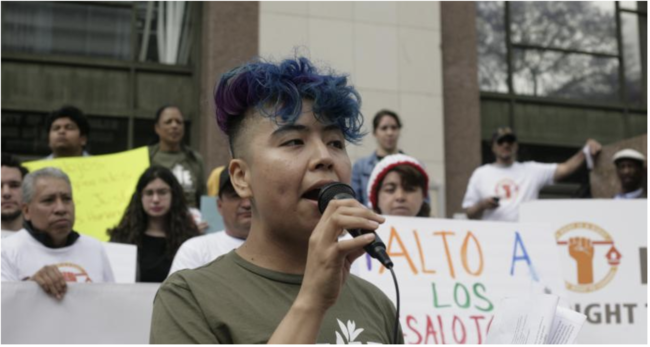Renter Vulnerabilities in Los Angeles
According to the Economic Policy Institute (EPI), 8.4 million jobs have been lost since the start of the pandemic in February 2020, and over 5 million people have reported cuts in hours and pay. Unemployment rates during the pandemic have varied widely by race/ethnicity and gender. EPI reports that, as of March 2021, the unemployment rate for Black workers is approximately 10%-nearly double the rate for white workers. The chart below, created by EPI, shows unemployment rates by race/ethnicity and gender at three different time intervals in the last year.
Due to entrenched systemic racism in our economic systems, Black and Latino workers are more likely to be unemployed during the pandemic, to be renting their housing, and to be “rent burdened,” meaning they pay more than 30% of their income on rent and utilities. A recent study by Pew Research Trust found that across the U.S., rent-burdened households have higher rates of eviction and financial fragility than other renters or homeowners. On a more regional level, a recent UCLA study reported that in Southern California, most low-income renters are rent burdened, and that eviction filings at the neighborhood level are most consistently associated with poverty rates and the presence of Black households. Thus, poverty, race, rent burden, and eviction are all interconnected. Since the start of the pandemic, scholars and activists have warned of a looming eviction crisis due to historic rates of unemployment and wage losses among renter communities that were already struggling to afford their housing prior to the pandemic.
Rent Burden in Los Angeles
In Los Angeles, housing affordability was a pressing issue before the start of the pandemic. According to 2019 data, 54% of L.A. County residents were renters, and over half of those renters were rent burdened. Further, 29% of all households were considered “severely rent burdened,” paying more than half of their income towards rent and utilities.

Households engage in many different coping mechanisms in order to adjust to rent burden. A recent study by the Price Center for Social Innovation investigating the effects of rent burden on residents in South and Central Los Angeles found that households were making significant cutbacks on critical basic needs in order to pay rent. The study found that two-thirds of rent-burdened households cut back on food, half cut back on clothing, half cut back on entertainment or family activities, half deferred bill payments and/or took on more debt, one-third decreased their transportation costs, and one-fifth went without medicine or seeing a doctor (Rosen, Angst, De Gregorio & Painter, 2020).
These coping mechanisms are often long term (cutting back for longer than five years) and can have permanent mental and physical effects on these rent burdened populations. Since rent burden disproportionately affects historically disinvested communities of color, the long-term effects of these coping mechanisms are felt especially badly by residents living in these areas, systemically leaving them at a disadvantage. Research shows that if the coping mechanisms are ineffective and households still cannot pay rent, rent burden could eventually lead to eviction, creating a cycle of housing instability: for example, evicted tenants are more likely to be evicted in the future, and may be screened and denied future housing due to the eviction on their record.
Evictions in Los Angeles
Eviction, when a tenant is expelled from their housing unit by the owner of the unit, has become a salient topic during the pandemic as households struggle more than ever to afford rent. National, state and local governments have enacted “eviction moratoriums” to help vulnerable renters maintain their housing during the pandemic. Even beyond COVID-19, eviction is a serious social problem that leads to negative and long-lasting physical and mental health effects for evicted families, higher residential mobility into lower-quality neighborhoods, and homelessness. Further, the effects of eviction are distributed unequally across lines of race and gender. A 2020 analysis of national eviction court filings showed that Black women face a disproportionate share of the burden of eviction, and that Black/Latinx female tenants suffer both higher eviction rates and higher rates of serial eviction filings (where landlords file eviction proceedings to collect rent and fees, with tenants covering the legal costs) than their male counterparts.

It is difficult to estimate the true prevalence of evictions in Los Angeles, in part because data on many formal evictions is court-protected information. Further, even if one could access all formal court measures related to evictions, many more evictions occur through informal and/or illegal means. One scholar found that for every formal eviction filed for a particular corporate landlord in Los Angeles, there were 6 informal evictions that occurred “off the books” (Montano, 2020). More research is needed to confirm the extent of the problem across the region, but this finding shows that formal evictions don’t necessarily track the crisis occurring beyond the courts with informal evictions.
One estimate of informal evictions could come through 911 calls to police that are related to landlord/tenant disputes. Such data includes tenants calling the police to report their landlords for things like utility shut-offs, window and door removal, illegal changes of locks, removal of parking, and other instances of landlords harassing, abusing, or informally evicting tenants. These calls can also include landlords calling the police to report tenants, which may be another form of harassment itself, particularly in communities of color where police are often seen as a threat. Between 2011 and 2019, there have been over 71,000 calls related to landlord/tenant disputes to LAPD. The map below shows calls in LA City neighborhoods over that time period.
Select a neighborhood on the graph to the right to see how it compares to the City average over time.
Rent Burden, Eviction, & Displacement
Many of the neighborhoods with high rates of rent burden and large numbers of landlord/tenant dispute calls are those that are experiencing rapid neighborhood change and residential displacement. For example, over the last few years, one pocket of the Jefferson Park neighborhood has experienced a sharp increase in rent burden and landlord/tenant dispute calls in the last decade. In 2012, 54% of the population in this particular census tract (2190.2) was rent burdened; by 2015, the rent burden rate had increased to 76%. The rate of landlord/tenant dispute calls quadrupled over a similar time period, increasing from 54 calls per 10,000 residents in 224 calls per 10,000 residents in 2016. The graphs below show the change over time in rent burden and dispute call rates in this Jefferson Park census tract and the City of Los Angeles as a whole.
Since these increases in rent burden and dispute calls, median income in the census tract has increased sharply, and the population with a bachelor’s degree nearly doubled between 2015 and 2019, suggesting that wealthier tenants may be moving into the neighborhood and displacing previous residents. While these data do not indicate causal impact, it’s critical for policymakers to recognize the relationship between rent burden, informal evictions and neighborhood displacement that is happening in Jefferson Park and many other neighborhoods around the City.
LA Renters' Right to Counsel Coalition
The Los Angeles Renters’ Right to Counsel Coalition (LA RTC) is a coalition of community-based organizations and law firms in LA County that works to ensure that those at risk of eviction are properly represented in court by lawyers. In Los Angeles, when faced with eviction, LA RTC estimates that just 10% of tenants have legal representation during eviction proceedings, compared to approximately 95% of landlords. Tenants without a lawyer almost always lose their cases, since cases move rapidly and are difficult to navigate without proper legal knowledge. By contrast, 84% of tenants who were provided representation in New York’s Right to Counsel program were able to remain in their homes.



In the Fall of 2020, LA RTC partnered with the County to create Stay Housed LA County, a program meant to keep tenants from experiencing eviction in light of the severe housing, economic, and debt crisis spurred on by the pandemic. Stay Housed LA County is an innovative program that links legal service providers, tenants’ rights advocacy organizations, and tenant unions together to provide outreach, education, and legal aid for tenants facing landlord harassment and/or eviction. The organization offers a newsletter, a website and workshops that educate residents of their rights as tenants and also helps renters connect with legal service providers that assist renters who cannot pay their rent or are threatened with eviction.
Looking Forward
The housing crisis is persistent and longstanding. Even beyond the context of the COVID-19 pandemic, households are continually under the threat of rent burden and eviction. LA RTC Coalition is currently advocating for several policy efforts to ensure the protection and housing stability of renters during this time:
- passing a codified right to counsel for tenants facing eviction,
- passing a strong tenant anti-harassment ordinance,
- supporting government subsidization of housing and community land ownership models, and
- eliminating all forms of COVID-19 rent debt.
These policies are especially important for historically disinvested communities, who are disproportionately affected by housing issues and systemically at a disadvantage to deal with them. Underlying issues with the housing crisis must be rectified to truly fight housing injustice.

Aileen Qin
Aileen is a Master of Urban Planning (Class of 2022) student at the USC Sol Price School of Public Policy with a concentration in environmental planning and analysis. She obtained her undergraduate degree in environmental studies with a minor in gender and sexuality studies from Rhodes College in Memphis, TN. Aileen’s interests lie in GIS mapping and public parks and her dream is to utilize GIS technology to create accessible greenspaces that serve as solutions to a wide variety of community problems. She is originally from Houston and enjoys hiking, farmer’s markets, and the color pink!
Sources
Bonett, G., McKeon, K., Harshbarger, T., Martin Moya, B., McGraw, C., & Nelson, K. (2019). Priced Out, Pushed Out, Locked Out: How Permanent Tenant Protections Can Help Communities Prevent Homelessness and Resist Displacement in Los Angeles County. Public Counsel and the UCLA School of Law Community Economic Development Clinic. http://www.publiccounsel.org/tools/assets/files/1188.pdf
Gould, E. (2021, April 2). Jobs and Unemployment. Economic Policy Institute. https://www.epi.org/indicators/unemployment/
Hepburn, P., Louis, R., Desmond, M. (2020). Racial and Gender Disparities among Evicted Americans. Sociological Science, 7: 629-662.
Jarvis, K. L., Zil, C. E., Ho, T., Herrera Allen, T., & Lucas, L. M. (2017) Evaluation of the Sargen Shriver Civil Counsel Act (AB590) Housing Pilot Projects. Judicial Council of California. https://www.courts.ca.gov/documents/Shriver-Housing-2017.pdf
Lens, M. C., Nelson, K., Gromis, A., Kuai, Y.(2020). The Neighborhood Context of Eviction in Southern California. City and Community, 19 (4), 912-932. https://doi-org.libproxy2.usc.edu/10.1111/cico.12487
Montano, J. (2020). Piercing the corporate veil of LLC landlordism: A predatory landlord’s eviction machine of black and brown bodies in Los Angeles’ working class neighborhoods, 1996-2019 [Unpublished master’s thesis]. University of California, Los Angeles, Master of Urban & Regional Planning.
NYC Office of Civil Justice. (2019). Annual Report. NYC Human Resources Administration Department of Social Services. https://www1.nyc.gov/assets/hra/downloads/pdf/services/civiljustice/OCJ_Annual_Report_2019.pdf
Pew. (2018, April 19). American Families Face a Growing Rent Burden. https://www.pewtrusts.org/en/research-and-analysis/reports/2018/04/american-families-face-a-growing-rent-burden
Renters’ Right to Counsel. (2019). Right to Counsel Coalition. Retrieved April 27, 2021, from https://rtcla.org/
Rosen, J., Angst, S., De Gregorio, S., & Painter, G. (2020). How do Renters Cope with Unaffordability: Household-Level Impacts of Rental Cost Burdens in Los Angeles. USC Sol Price Center for Social Innovation. https://socialinnovation.usc.edu/wp-content/uploads/2020/12/USC-PRICE_Rent-BurdenReport_12.14.pdf
Stay Housed L.A. County. (2020). Retrieved April 27, 2021, from https://www.stayhousedla.org/
Photo Attributions
Cover Photo: Photo courtesy of Istock/MattGush
Photo 1: Photo courtesy of Istock/georgeclerk
Photo 2: Photo courtesy of Istock/mrdoomits
Photos 3-5: Photos courtesy of the LA Renters’ Right to Counsel Coalition

